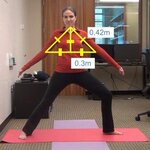Technology

If you are new to a yoga class, you are stunned by how flexible and strong its participants are - but if you are blind in a visual exercise world, it takes a little more creativity to feel the burn. Technology to the rescue.
Students traditionally watch an instructor to learn how to properly hold a position, not possible for blind people, but University of Washington computer scientists have created a software program that watches a user's movements and gives spoken feedback on what to change to accurately complete a yoga pose.
The program, called Eyes-Free Yoga, uses Microsoft Kinect…

New research marks an important step toward new technology that, if implemented successfully, would increase the dexterity and clinical viability of robotic prosthetic limbs - touch-sensitive prosthetics that could convey real-time sensory information to amputees via a direct interface with the brain.
The researchers are working specifically on the sensory aspects of these limbs. In a series of experiments with monkeys, whose sensory systems closely resemble those of humans, they indentified patterns of neural activity that occur during natural object manipulation and then successfully…

Phones are terrific today. They can play games and watch videos and check email - they are just terrible at making calls.
And during a natural disaster, when too many people take to their mobile phones at once, cellular networks easily overload. Mai Hassan, a PhD student in the Department of Electrical and Computer Engineering at the University of British Columbia, has developed a solution to ensure that calls don't get dropped and texts make it to their destination.
Hassan found a way to opportunistically use television and radio channels to transmit cellular signals when…

Healthcare workers' use of disposable gowns and gloves upon entering all patient rooms on an intensive care unit, versus only in rooms on standard isolation protocol, helped reduce patient acquisition of methicillin-resistant Staphylococcus aureus (MRSA) by approximately 40 percent, according to new research.
The study did not show statistically significant results for preventing patient acquisition of another common bacteria, vancomycin-resistant Enterococcus (VRE) and the use of gowns and gloves increased handwashing frequency among healthcare workers and did not result in any increase in…
Internet algorithms have done lots of wonderful things but can they help you live your life?
In the past, algorithms helped you find better encyclopedia answers to questions, but that is very 1990s. Google is not a search engine company now, they are an ad company that has a search engine front-end and their searches end up at Wikipedia or About.com so you're better off just going directly to those.
Modern algorithms are instead recommendation engines tailored to you.
You've seen them everywhere; when you go to Netflix and watch "Archer" and like it, their algorithm will recommend "The…

Fiber-optic sensors running along a 36-km stretch of high-speed commuter railroad lines connecting Hong Kong to mainland China have taken more than 10 million measurements over the past few years, a demonstration that the system can help safeguard commuter trains and freight cars against accidents.
Attuned to the contact between trains and tracks, the sensors can detect potential problems like excessive vibrations, mechanical defects or speed and temperature anomalies. The system is wired to warn train operators immediately of such problems so that they can avoid derailments or other…

Galaxy Zoo 2, the second phase of a crowdsourcing effort to categorize galaxies in our universe, has leveraged more than 83,000 citizen scientists to obtain over 16 million galaxy classifications and information on more than 300,000 galaxies.
That's what you get when you ask the public for help in learning more about our universe. Computers are good at automatically measuring properties such as size and color of galaxies, but more challenging characteristics, such as shape and structure, can only be determined by the human eye.
An international group of researchers has just…

Traditional peer review is not enough to ensure data quality amid the recent boom in scientific research findings and open access places to publish them, according to results of a 10-year collaboration between the National Institute of Standards and Technology (NIST) and five technical journals.
Managing thermophysical property data is particularly challenging because some 100-year-old data remain useful today for engineering purposes. Efforts to establish data-reporting standards for this field began more than 50 years ago but could not succeed until recently, with the development of…

A new citizen science project allows you to explore the open ocean from the comfort of your home. You can 'dive' hundreds of feet deep, and observe the unperturbed ocean and the myriad animals that inhabit the earth's last frontier.
The goal of the project is to enlist volunteers to classify millions of underwater images to study plankton diversity, distribution and behavior in the open ocean - even cheaper labor than post-docs.
Millions of plankton images are taken by the In Situ Ichthyoplankton Imaging System (ISIIS), a unique underwater robot created by Charles Cousin at Bellamare…

An environmentally-friendly electronic alloy consisting of 50 aluminum atoms bound to 50 atoms of antimony may be promising for building next-generation "phase-change" memory devices, which could be an alternative to slower speed, lower storage density flash memory for data storage applications.
Phase-change memory relies on materials that change from a disordered, amorphous structure to a crystalline structure when an electrical pulse is applied. The material has high electrical resistance in its amorphous state and low resistance in its crystalline state -- corresponding to the 1 and 0…